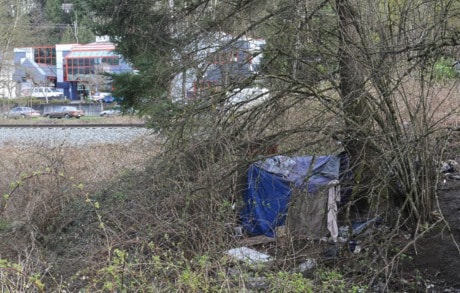The number of homeless people in Abbotsford and Mission has been virtually cut in half, according to the one-day snapshot that is the homeless count.
The Fraser Valley Regional District (FVRD) and Mennonite Central Committee (MCC) have released preliminary results from the 2011 count. Volunteers across the FVRD communities visited shelters, soup kitchens, homeless service providers and doorways, to get a 24-hour snapshot of the homeless population. They chose a 24-hour period that started March 15 at 10 p.m.
The 2011 count found 117 homeless in Abbotsford, down from 235 in the 2008 count.
Similarly, Mission's homeless population plunged from 100 in 2008, to 54 in 2011.
Across the region, the homeless population dropped from 465 to 345 – a 25 per cent reduction.
"That's due to a lot of incredibly hard work by agencies and volunteers," said Patricia Ross, the FVRD chairperson. "We need to celebrate the successes we've had."
Ross said municipalities across the Lower Mainland have put more focus on homeless initiatives.
Ron Van Wyk of the MCC noted that there is still much work to be done with the data obtained from the count. Volunteers conducted a lengthy survey, asking homeless people their age, home community, reasons for being homeless, sources of income and other questions. That information has yet to be tabulated, and a more detailed report produced.
But he said there is reason to celebrated the substantial reductions in Abbotsford and Mission. Even before the official count began, the anecdotal evidence showed fewer people living on the streets in those communities.
"Some of the services that have been provided seem to be working," he said.
"That's why the programs are there. There are outreach programs in all communities designed to connect homeless people with programs and services."
Van Wyk said two new operations in Mission – a new 24-hour emergency shelter and a second-stage housing facility – appear to have had a dramatic effect in reducing the number of people forced to live outdoors.
Abbotsford has two new housing projects coming on stream directed at homeless people and those in danger of becoming homeless. One for 30 men at the Kinghaven site, and another for 41 women and their children on Clearbrook Road, on city-ownnede land at the same site as Matsqui Recreation Centre. Those buildings will be onstream by the time the next homeless count is done in three years.
"Those are very good initiatives, that have to make an impact," said Van Wyk.
There are still unanswered questions. He said the volunteers conducting the count found that many of the places in Abbotsford where homeless camps had been were cleared of trees. That leaves the question of whether some homeless people had been simply displaced.
Not all the news was good. The eastern communities in the FVRD all experienced increases. Chilliwack from 98 to 111, Agassiz-Harrison from 12 to 20, and Hope from 20 to 43.
Ross found the increase in Hope particularly surprising, because a 25-bed shelter recently opened there.
"It's puzzling. We have to look at why – what's behind the numbers," she said.
"There's a ways to go. There are still people out there who need our help."
Homeless Stats
- The most common age groupt among homeless people is 25-34, making up 26 per cent. There were 2.9 per cent of the homeless population found to be under 15.
- More men than women are homeless, the gender divide being 55 per cent male, and 45 per cent female. However, preliminary results show the percentage of homeless women appears to be on the increase in the region.
- On the day of the count, 78 per cent of those considered homeless were without shelter, and 22 per cent were sheltered.
- 44 per cent of homeless are on welfare. Almost 19 per cent have no income, while 1.7 per cent were employed full time.
- 46 per cent reported having health issues, and 53 per cent of those have multiple health conditions.
- 27 per cent have an addiction.
- 6.3 per cent have mental illness, and 6.8 per cent have a physical disability.
- When asked: "What will end homelessness for you," 38 per cent said affordable housing, 18 per cent employment, 17 per cent higher income and nine per cent overcoming addiction.
